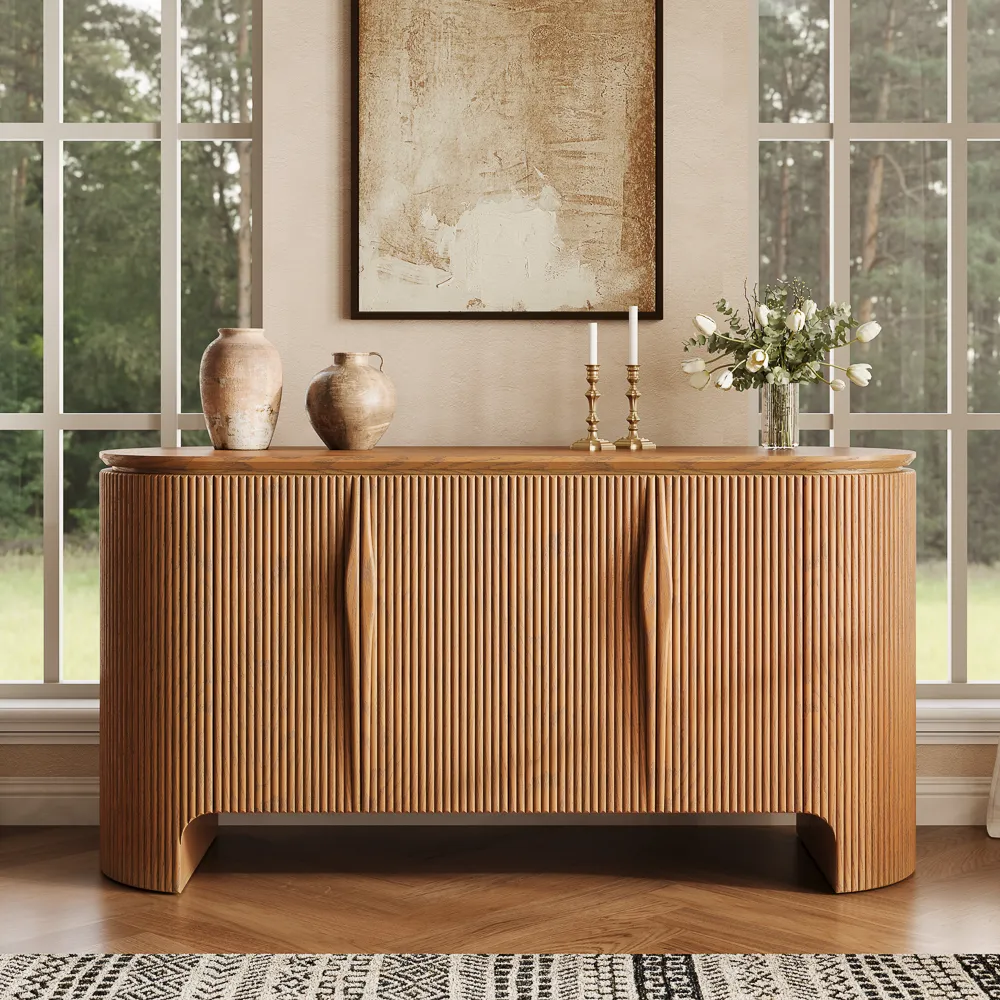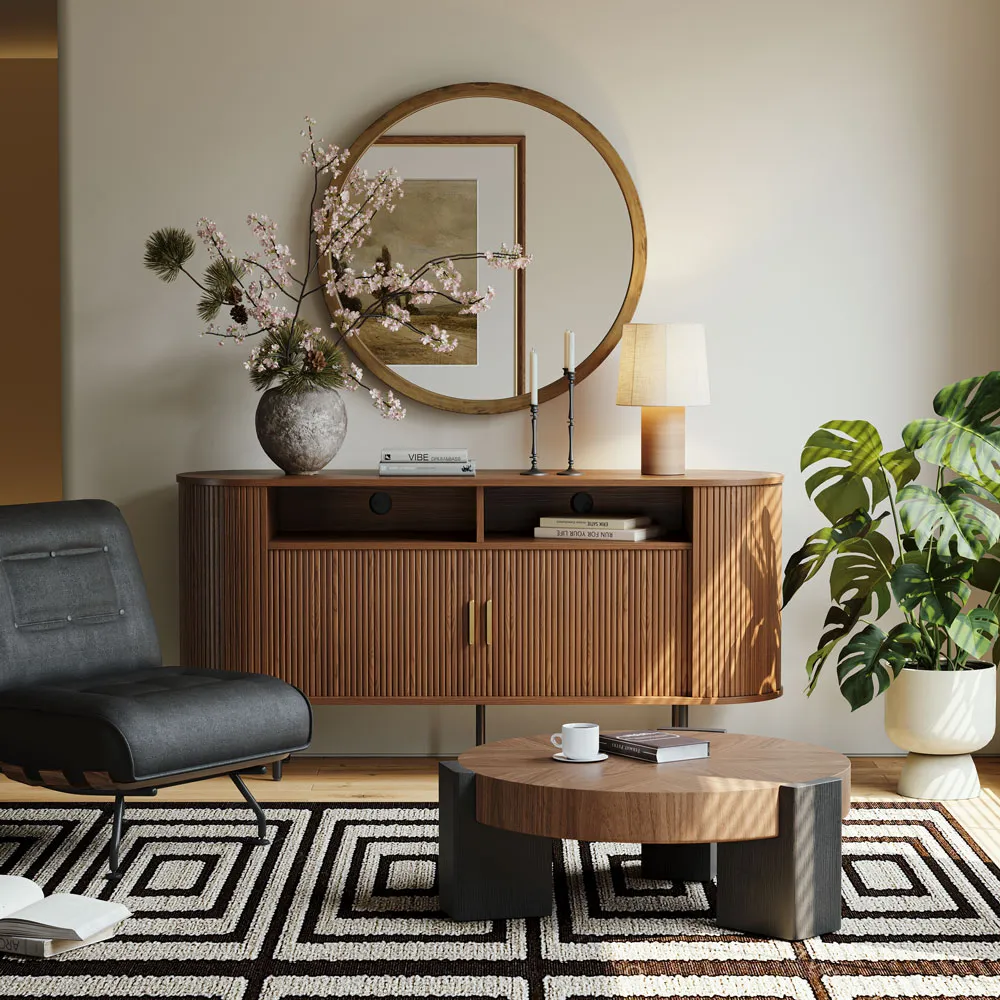That’s where a mid-century modern cabinet comes in. It’s not just another piece of furniture—it’s the missing link between function and style. Whether you’re decorating your living room or refining your dining space, this guide will show you how to use mid-century cabinets to bring balance, beauty, and smart storage into your home.
What Is a Mid-Century Modern Cabinet?
A mid-century modern cabinet features hallmark design cues from the 1940s to 1970s: clean lines, warm woods (especially walnut or teak), minimalist hardware, and legs that are often tapered and angled. Unlike bulky traditional units or hyper-minimal modern ones, these cabinets offer timeless charm while remaining highly functional.
Users on Quora and Reddit often ask: “Is this style still relevant?” Absolutely. Its simplicity makes it adaptable, and its solid construction offers long-term value. Whether it’s a sideboard in your dining room or a media console in your living room, it always feels intentional, never outdated.
Why Is It Still So Popular?
Mid-century cabinets are beloved for a reason. They offer:
-
Streamlined forms that visually declutter your room
-
Rich textures and warm tones that blend with modern, boho, or Japandi styles
-
Multifunctionality—they can serve as buffets, TV stands, entryway consoles, or even bar stations
On Reddit, one user shared: “I bought a mid-century cabinet because I was tired of open shelving. I stayed because it made my whole room look finished.”
Choosing the Right Cabinet for Your Needs
Before selecting a cabinet based on style alone, ask yourself:
-
What do I need it to hold? Dishware, electronics, linens?
-
How much space do I have? Vertical or horizontal layout?
-
Where will it live—living or, dining room, or somewhere in between?
If you need flexible interior space, go for designs with adjustable shelves and closed doors. For tight areas, consider compact options with sliding tambour doors, which save space without sacrificing style.
A good rule of thumb: pick a piece that solves a problem first, and looks beautiful second (but luckily, mid-century modern offers both).
Living Room Styling Tips
Mid-century cabinets shine when placed where they can be admired, not crammed between larger furniture. Ideal spots include:
-
Opposite the sofa
-
Beneath a wall-mounted TV
-
On an empty wall that needs anchoring
In open-concept spaces, a low cabinet can also act as a soft divider between the living and dining zones. For example, a compact piece like the Mid Century Modern Side Cabinet with Tambour Door works beautifully in small apartments or tighter layouts, thanks to its space-saving sliding tambour door and clean walnut finish. It tucks neatly beneath a wall mirror or artwork without stealing attention—perfect for styling with a lamp, a small stack of books, or a potted plant.
When styling the top, group décor in odd numbers (e.g., lamp + vase + book stack), introduce contrast with ceramics or black metal, and leave negative space for a clean, breathable look.
Dining Room Styling Tips
A mid-century modern cabinet makes the perfect sideboard for storing dishware, placemats, or bar tools. Top it with:
-
A tray of decanters or a wine rack
-
Fresh florals or sculptural candle holders
-
A framed print or mirror above to draw the eye upward
In larger dining areas, consider a sculptural option like the Mid Century Modern Cabinet with Adjustable Shelves. Its rounded edges and fluted walnut front bring softness and texture to the space, while the adjustable shelves keep your storage adaptable and hidden. This piece doesn’t just store your hosting essentials—it anchors the room with style and grace.

Wondering whether it should match your dining table? Aim for cohesion, not identical finishes. For example, pair a walnut cabinet with light oak chairs, or repeat brass accents from the cabinet hardware in your chandelier or cutlery.
Horizontal vs. Vertical Layouts: What Works Best?
On Reddit, users often ask: “Should I go for a tall cabinet or a low sideboard?” Here’s how to choose:
-
In wide rooms, horizontal pieces like sideboards help the eye travel and visually widen the space.
-
In narrow rooms or small apartments, vertical cabinets make ceilings feel higher and use space more efficiently.
-
In shared open areas, a low cabinet can subtly divide the room without interrupting the flow.
What Furniture Goes Best with Mid-Century Cabinets?
To create a unified, balanced look:
-
Match lines, not just materials: Pair your cabinet with other pieces that have tapered legs or slim profiles.
-
Soften angles with curves: Round mirrors, oval dining tables, or globe lamps add contrast and warmth.
-
Stick to a palette: Use 2–3 wood tones at most, and repeat materials across the space for cohesion.
-
Bring in texture: Leather, velvet, and woven fabrics play beautifully against walnut wood.
Mid-century furniture shines when everything feels curated, but not over-designed.
Common Mistakes to Avoid
Even great furniture can fall flat if not styled well. Watch out for:
-
Overcrowding the surface: Let the cabinet breathe—use décor sparingly.
-
Clashing wood tones: Choose woods that either contrast clearly or stay within the same undertone family.
-
Forgetting lighting: Use a table lamp, wall sconce, or nearby window to showcase the cabinet’s finish.
-
Placing it too close to other furniture: Give it 6–12 inches of clearance for ideal flow.
Ready to Bring Timeless Design Home?
A mid-century modern cabinet isn’t just a storage upgrade—it’s a stylistic investment. Whether you’re styling a cozy corner, anchoring an open layout, or upgrading your dining room setup, this piece offers versatility that lasts for decades.
Explore more inspirations on our Mid-Century Modern Cabinet Collection, or browse the full Living Room Cabinets & Chests selection to discover the right cabinet for your home.
With Povison—the world’s best fully assembled furniture brand—you don’t just decorate. You elevate.
What to Read Next:

